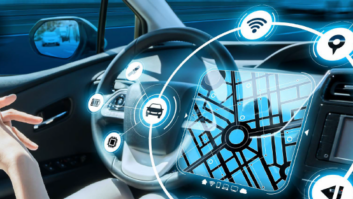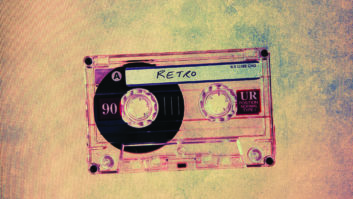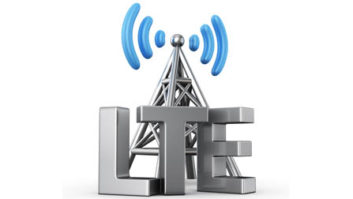The author is president, Tom Ray Broadcast Consulting, New Windsor, N.Y.

The author is shown in a 2015 Cadillac CTS. Roughly four and a half years ago, I wrote an article in the pages of Radio World about my search for a new car with HD Radio as an integral part of the package. I settled on a 2010 Ford Escape.
My experience then of trying to find a vehicle factory-equipped with an HD Radio receiver, or of buying one as an option, was not good (“HD Radio Shouldn’t Be This Hard,” RW Aug. 11, 2010). A memo on the Ford website had stated that HD Radio would be an option, but this was in error and there was no factory radio available for that vehicle. And equipping it with an aftermarket solution was an exercise in frustration. Dealer staff did not even know what HD Radio was.
That was then.
While I am not in the market for a new car yet (my Escape runs well, thank you), Radio World asked me to don my Joe Consumer hat and go shopping again for a new car with a factory HD Radio receiver and to see whether dealer employees had a better grasp of the HD Radio concept.
What I found in my mid–November search was still discouraging overall, though with some qualifications.
PLANNING
To start, I did some research. According to the website goodcarbadcar.com, the top five auto brands in the U.S., based on projected number of vehicles sold in 2014, are General Motors, Ford, Chrysler Group, Toyota and Honda.
Well, lucky me. Not far from home on Route 17K in Newburgh, N.Y., about 50 miles north of New York City, there are numerous car dealerships. I stopped at four (skipping Honda because a truck full of new vehicles arrived when I was there, and I decided they didn’t need my nonsense at that time).
I also visited hdradio.com and took a look at the brands iBiquity Digital Corp. says have HD Radio. Here I encountered my first problem. In the majority of cases, HD Radio is available mostly in the top-tier vehicles of manufacturers. Bluntly, I feel that if HD Radio is to succeed, Joe Consumer needs to be able to find it in the mainstream vehicles he drives.
(HD Radio also comes in Bentleys. I know one person who owns a Bentley; I can assure you he does not live anywhere near my neighborhood and most likely is not a listener to any station I have been associated with.)
I have some other statistics to reveal soon.
FORD
I considered just starting to shop, but I had two concerns.
First, I did not want to lead a sales guy on, only to have the conversation turn into an HD Radio education session with no chance of a sale. Second, the people at the Ford dealership know me, so it was only fair to identify myself and what I was up to at other dealerships.
I walked into Ford and, after their shuddering stopped, I was teamed with two salespeople who knew what HD Radio was. While chatting, it became apparent that they were not familiar with HD multicast channels, so I took the opportunity to educate them.
HD Radio at Ford is standard in high-end vehicles and available as an option in all other vehicles — except the lower-priced Fiesta. To add it as an option, you need the MyFord Touch package, which is in the neighborhood of an additional $4,000. HD Radio comes with MyFord Touch; it’s incorporated into the GPS-equipped radio system.

The HD1, HD2 and HD3 channels of WJGK(FM), Newburgh, N.Y., are displayed on the tuner in a Cadillac CTS. As an example, a base-priced Ford Focus is $16,810. To get the MyFord Touch package, you need to upgrade to the Titanium option, making the car $23,900 list, with a street price of around $21,650. That’s not too bad; and you get the cool in-dash GPS unit, which most likely is the selling point, though one needs to ask whether an extra $5,000 is worth the cost if you already have a nice GPS and just want HD Radio without other bells and whistles like Bluetooth connectivity for audio and USB ports for audio devices. (This list reminds us too that along with HD Radio comes more competition.)
Note that Ford announced in December it intends to replace MyFord Touch with a new infotainment system based on its Sync AppLink. Called Sync3, the system will start appearing in model year 2015 Fords and Lincolns.
CHRYSLER
Over at the Chrysler dealer, I encountered a sales person who was new on the job. At first, he corrected me by saying, “Oh, you mean SiriusXM Satellite Radio.” Um, no, I mean HD Radio — over-the-air digital. He had to look it up, but quickly told me that it was available as an option in the Chrysler 200. He told me that satellite radio was available in all Chrysler vehicles, but HD Radio was only available in the 200 if the car is equipped with a Uconnect system. HD Radio then is either an upgrade or comes standard, depending on which version of Uconnect is available for the individual trim model.
The base price on a Chrysler 200 is $21,700. The Uconnect, which includes GPS navigation and of course SiriusXM, adds roughly another $1,495, which I thought was a fair price for what you get. Again, he was new, and was not aware of HD Radio or HD multicast channels — so we had a good discussion.
Chrysler has since announced that its 2015 model 300, equipped with the Uconnect system, offers HD Radio, too. Some trim levels of the 300 include the premium Uconnect 8.4AN, which includes HD Radio; other trim levels offer the Uconnect 8.4AN as an upgrade option.
GM
I had better luck at the GM dealership, which offered Cadillac and Chevrolet vehicles. The sales person was knowledgeable and adept with the HD system, and knew about multicast channels.
He told me that all 2015 Cadillac models offer HD Radio as an option except for the Escalade, in which HD Radio is standard.
In the Chevy line, the 2014 Traverse, Silverado and Impala have HD Radio available optionally. The vehicle must include the MyLink package, which incorporates HD Radio. However, Chevrolet has stated that HD Radio will not be an option in the these three models starting with the 2015 model year, as Radio World has reported. These vehicles have been on the lots since mid-2014. In my mind, this is a tremendous loss, as the Impala is a common vehicle on the road.
The GM salesperson had some interesting things to add. His commute is about an hour. He told me he does not listen to over-the-air radio because “it’s the same stuff over and over,” and he has to change stations constantly as he goes out of range. He said he will listen to Pandora about once per week. But he’s tech savvy and understands that, on an hour-long commute, he could blow quickly through his data allotment on his cellular contract.
Still, he can listen to Pandora through the Bluetooth connection on his phone or through the onboard OnStar system data package in his car. He also stated that he has not looked at his iPod in roughly 3 years — because it is in the center console of the car tethered to the audio system through a USB connection. He listens to either his iPod or Pandora simply for the variety offered.
He also said I was the only person who had ever asked about HD Radio. Ever.
TOYOTA
Finally, I stopped at the Toyota dealer.
Toyota gets it. They have four radio models. The base one does not have HD; the other three do and have varying degrees of amenities. The only Toyota model that does not have an option for HD Radio is the Yaris, their lower-priced model.
He stated that Toyota is trying to simplify consumers’ lives and, in the next model year — 2016 — the automaker will only have one model of radio for the vehicles; it will include HD Radio, so the technology will be standard in all Toyota vehicles.
The unfortunate part of Toyota’s pricing is that they do not break out the radio cost on their window stickers. And when you upgrade to a higher radio for the vehicle, there are other options included, so it is difficult to assess the cost of the upgraded radio.
HD ROLLOUT
Here are interesting statistics from motorintelligence.com: As of Dec. 2, there were 3.02 million mid-size vehicles sold in the U.S. in calendar year 2014, as well as 2.66 million small vehicles, 965,000 luxury vehicles and 7.07 million light-duty trucks (which includes minivans, SUVs and crossover vehicles).
It’s nice that HD Radio is available in the luxury vehicles; but luxury vehicles make up 7 percent of the motoring public. You need HD Radio available, reasonably priced, in the other 12.7 million vehicles sold to make the medium viable.
Don’t forget, you have Pandora, other Internet services, iPods, flash drives and many other forms of entertainment for the driving public to avail themselves of.
Yes, iBiquity Digital has told me numerous times that there are “politics” involved in getting the technology into cars. That’s nice. Then how about fighting for our place in the dashboard and get us into the mainstream vehicles? That is what we, the broadcasters, need after we put large amounts of money into taking our stations HD.
IBiquity projected recently that its HD Radio technology would be in some 43 percent of cars sold in the U.S. in 2014 and believes that figure will rise to about 50 percent in 2015.
Looking at the iBiquity website list of models that support HD Radio, as of mid-November, the technology was still only available for the most part in luxury vehicles. The company’s penetration projections do not make sense to me, seeing as Chevy has dropped HD Radio in the three models mentioned for the 2015 model year. Walking around car lots, I did not see one vehicle equipped with an HD Radio receiver where the technology was an option. They all had analog radios factory installed.
While HD Radio is available as on option in numerous vehicles, if the public does not know what it is or why they would need it, why would they spend the money to have one put in the car? Fourteen years in, I feel that this is inadequate, especially compared to the rates of adoption of other media delivery platforms.
And yes, let’s go down this road: We, the broadcasters, need first to offer content that will keep the listeners from seeking the alternatives on a regular basis. You don’t get the same 300-song playlist constantly with your iPod, and you don’t get the drivel that is the vast wasteland of talk radio these days. Content is king.
Then stations need to do a better job of talking about HD Radio technology and its advantages other than mentioning it only in the top-of-the-hour station ID.
It is still a frustrating experience to shop for HD Radio in vehicles, though it’s much better than it was in 2010. FM stereo took 20 years to become mainstream. I took WOR Radio in New York City HD in 2002, 14 years ago, and there hasn’t been much progress with the public yet. We still have a long way to go.
Tom Ray is former corporate director of engineering of Buckley Radio and WOR Radio in New York. He has experience with AM and FM HD Radio; in 2002 WOR became the first full-time high-power AM HD Radio station. He operates Tom Ray Broadcast Consulting in New Windsor, N.Y. Reach him at[email protected].











